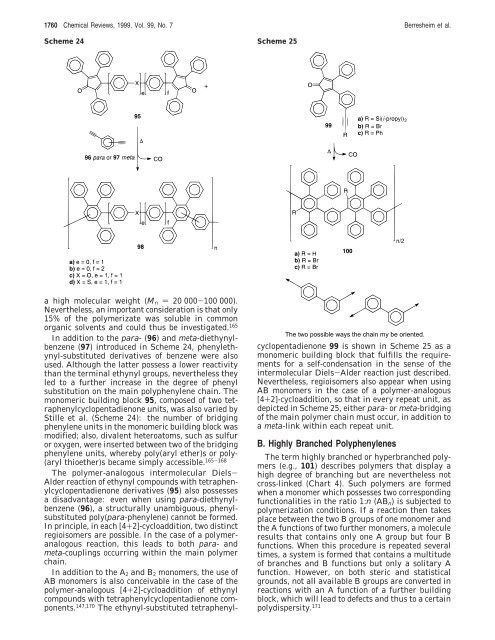Polyphenylene Nanostructures - Cluster for Molecular Chemistry
Polyphenylene Nanostructures - Cluster for Molecular Chemistry
Polyphenylene Nanostructures - Cluster for Molecular Chemistry
Create successful ePaper yourself
Turn your PDF publications into a flip-book with our unique Google optimized e-Paper software.
1760 Chemical Reviews, 1999, Vol. 99, No. 7 Berresheim et al.<br />
Scheme 24 Scheme 25<br />
a high molecular weight (Mn ) 20 000-100 000).<br />
Nevertheless, an important consideration is that only<br />
15% of the polymerizate was soluble in common<br />
organic solvents and could thus be investigated. 165<br />
In addition to the para- (96) and meta-diethynylbenzene<br />
(97) introduced in Scheme 24, phenylethynyl-substituted<br />
derivatives of benzene were also<br />
used. Although the latter possess a lower reactivity<br />
than the terminal ethynyl groups, nevertheless they<br />
led to a further increase in the degree of phenyl<br />
substitution on the main polyphenylene chain. The<br />
monomeric building block 95, composed of two tetraphenylcyclopentadienone<br />
units, was also varied by<br />
Stille et al. (Scheme 24): the number of bridging<br />
phenylene units in the monomeric building block was<br />
modified; also, divalent heteroatoms, such as sulfur<br />
or oxygen, were inserted between two of the bridging<br />
phenylene units, whereby poly(aryl ether)s or poly-<br />
(aryl thioether)s became simply accessible. 165-168<br />
The polymer-analogous intermolecular Diels-<br />
Alder reaction of ethynyl compounds with tetraphenylcyclopentadienone<br />
derivatives (95) also possesses<br />
a disadvantage: even when using para-diethynylbenzene<br />
(96), a structurally unambiguous, phenylsubstituted<br />
poly(para-phenylene) cannot be <strong>for</strong>med.<br />
In principle, in each [4+2]-cycloaddition, two distinct<br />
regioisomers are possible. In the case of a polymeranalogous<br />
reaction, this leads to both para- and<br />
meta-couplings occurring within the main polymer<br />
chain.<br />
In addition to the A2 and B2 monomers, the use of<br />
AB monomers is also conceivable in the case of the<br />
polymer-analogous [4+2]-cycloaddition of ethynyl<br />
compounds with tetraphenylcyclopentadienone components.<br />
147,170 The ethynyl-substituted tetraphenyl-<br />
The two possible ways the chain my be oriented.<br />
cyclopentadienone 99 is shown in Scheme 25 as a<br />
monomeric building block that fulfills the requirements<br />
<strong>for</strong> a self-condensation in the sense of the<br />
intermolecular Diels-Alder reaction just described.<br />
Nevertheless, regioisomers also appear when using<br />
AB monomers in the case of a polymer-analogous<br />
[4+2]-cycloaddition, so that in every repeat unit, as<br />
depicted in Scheme 25, either para-ormeta-bridging<br />
of the main polymer chain must occur, in addition to<br />
a meta-link within each repeat unit.<br />
B. Highly Branched <strong>Polyphenylene</strong>s<br />
The term highly branched or hyperbranched polymers<br />
(e.g., 101) describes polymers that display a<br />
high degree of branching but are nevertheless not<br />
cross-linked (Chart 4). Such polymers are <strong>for</strong>med<br />
when a monomer which possesses two corresponding<br />
functionalities in the ratio 1:n (ABn) is subjected to<br />
polymerization conditions. If a reaction then takes<br />
place between the two B groups of one monomer and<br />
the A functions of two further monomers, a molecule<br />
results that contains only one A group but four B<br />
functions. When this procedure is repeated several<br />
times, a system is <strong>for</strong>med that contains a multitude<br />
of branches and B functions but only a solitary A<br />
function. However, on both steric and statistical<br />
grounds, not all available B groups are converted in<br />
reactions with an A function of a further building<br />
block, which will lead to defects and thus to a certain<br />
polydispersity. 171

















